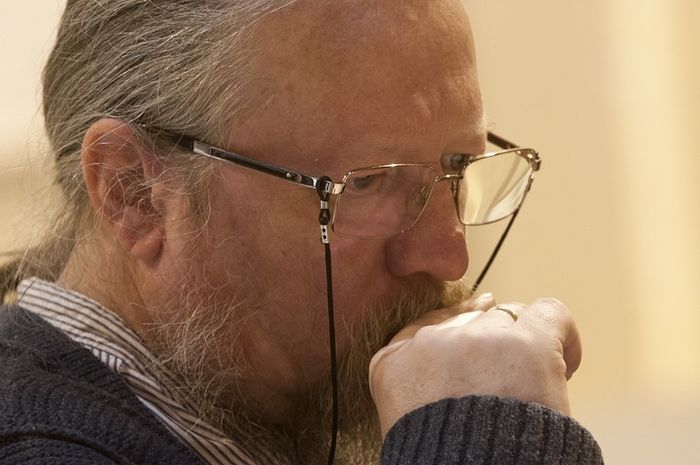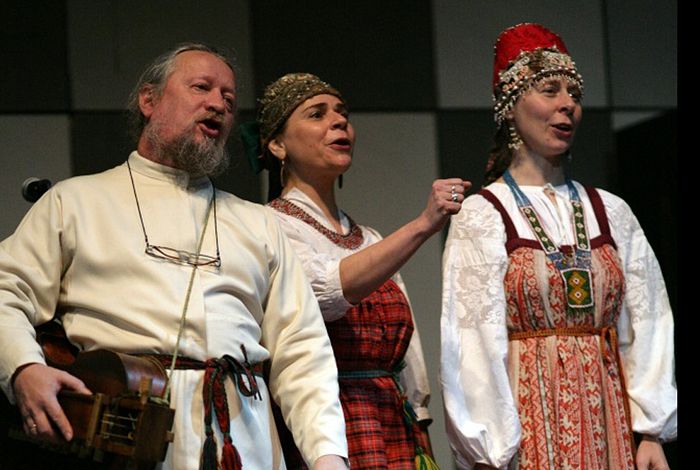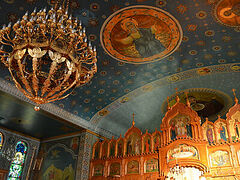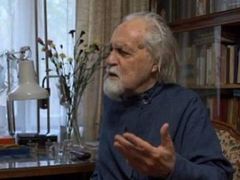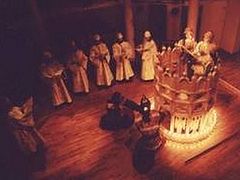Andrey Nikolayevich Kotov is the leader of Sirin, an old Russian spiritual music ensemble. He is also a singer and composer. As we continue our publications about traditional culture, we decided to ask him about authentic singing, its significance, and other aspects of old Russian spiritual music.
—Andrey Nikolayevich, could you please tell us about your artistic journey. When did you embrace the traditional Russian culture? What was the attraction?
—I embraced traditional music a long time ago, as I used to work in D. Pokrovsky’s ensemble, which explored traditional Russian culture, Cossack traditions, Russian folk theater, spiritual poetry, and Old Believers’ rituals.
I’ve been singing all my life. My mother was a singer too. I knew opera and Soviet pop songs of the 1960s. I sang in a choir and a folk orchestra. When I was a teenager, I formed a band. I also sang Russian bards’ songs and went hiking. I was interested in all types of good music.
I studied at the folk music department of the Gnesins Institute. However, I didn’t understand the concept of folklore yet. About two weeks after my studies started, my teacher gave me an assignment: I had to transcribe the recording of a three-part song. And when I heard the song… I was stunned! The song had an incredibly beautiful harmony of voices. And I realized that this authentic music was so much different from anything I had heard before. It was an eye-opener for me.
 Andrey Kotov among the members of the Dmitry Pokrovsky Ensemble
Andrey Kotov among the members of the Dmitry Pokrovsky Ensemble
The head of my department introduced me to Dmitry Pokrovsky in 1978. After serving in the army, I re-joined Pokrovsky’s ensemble. It was a legendary group of people. They were the first to perform authentic folklore rather than some cheesy folk songs. The ensemble was popular. It made folklore relevant again and raised it to the level of serious music. Our concerts were frequented by writers, poets, musicians… We were friends with V. Rasputin, A. Schnitke, and R. Schedrin. For them, our concerts were a breath of fresh air. We practically conquered the hearts of everybody in the Soviet Union. Our performances popularized folklore and inspired people to from new folklore ensembles in many cities.
I worked in Pokrovsky’s ensemble for ten years. Pokrovsky always wanted his students to pursue various interests, so he suggested that I explore spiritual poems and old Russian music. I was interested in everything new, so I agreed. Pokrovsky introduced me to people who used to go on ethnological expeditions. I met D.S. Likhachov and listened, amazed, to his stories. I was working on deciphering the Znamenny notation1 in ancient manuscripts. It was very difficult. If you decide to learn how to sing using the Znamenny notation, it might take you a month, but deciphering it can be done only by highly qualified professionals.
The destinations of my expeditions were recommended by the experts. In Riga, I met I.N. Zavoloko, a Pomor2 mentor, and copied his entire archive! When I visited the Don region, I transcribed the songs of the Old Believer Cossacks. I also met the Nekrasovite Cossacks. They sang from memory, without referring to any notation. They kept the Pre-European melodic language (one of the versions) and used the narechnoye singing technique.3
—Old chants were sung using naonnoye singing technique.4 How is this tradition perceived today?
—Speaking of naonnoye singing… Even the Old Believers have never fully figured it out, let alone those who corrected the technique nowadays. As a professional musician, I understand that all the word endings in naonnoye singing are sung with vowelization. That is, when a word ends with a consonant but the melodic phrase has to be continued, for example when you sing the word “посрамихом”, the znameny singers of old would sing an additional sound of “o” to account for two additional sounds that were supposed to follow the word. But this addition had nothing to do with the word, it was just a sound. So, if you consider these sounds as linking components rather than parts of words, then everything falls into place. It seems that the people who were correcting the old books didn’t perceive Znamenny singing5 as an expression of living words; it was just music for them. They were raised to follow the European way of thinking that separated the words from music. That was why they considered words to be separate from sounds. Meanwhile, people who sang extensive Znamenny chants where the melodic phrases were long and the words were short, would add these vowels so that they could sing the melodic phrases. For me, as a singer, it was obvious. If you sing it as sound rather than as a word, the word is not distorted.
God Is With Us (a fragment), A Znamenny Chant-based Hymn, Tone 8. Sirin Ensemble.
—What do you feel when you hear Znamenny singing?
When you sing in unison, you merge into a single voice with the entire choir. You don’t hear yourself sing, instead you hear the prayer and become a part of it.
—In Pokrovsky’s Ensemble we sang Fyodor Krestyanin’s sticherons transcribed by M.V. Brazhnikov. These stichera dating back to the sixteenth century were included in the Masterpieces of Ancient Russian Singing published in the 1970s. I was mesmerized by the power of the chant and the feeling invoked by unison singing. Few people can do it today. When you sing in unison, you don’t hear yourself singing as your voice merges with the entire choir. It is called “singing with one mouth”. Neither your voice, nor the voice of the cantor can be distinguished. You don’t hear yourself sing, you hear the prayer and become a part of it. For a modern man, it is difficult to understand, because to a certain extent we are all raised as individualists, we all have our egos and our own beautiful voices… While for traditionalists, singing together means experiencing feelings together. As such, none of them would ever compete with other singers or show off their abilities, because the most valuable thing for them is being together. This idea of singing “with one mouth” is the most valuable thing in unison singing. Modes, rhythms or keys may change, but it is not important. When I went on ethnological expeditions, my goal wasn’t a simple collection of materials, I wanted to understand why znamenny chants are sung in this particular way and in no other way.
—How does Russian traditional singing help you in life?
—We keep saying the word “tradition”, but what does it mean? It is a collection of positive experiences that is handed down from generation to generation because it is good. Like traditional recipes from our grandmother, we receive it from our ancestors, because despite the temporality of everything in this world, some valuable things can be passed on to future generations. And it is done in a way that is relatable and valuable for children.
Traditional singing is a part of traditional life. If there’s no traditional society, there won’t be any traditional singing. It will either become an archaic art or simply disappear. I am a professional musician and this is all music to me, but when I met some traditionalists during my expeditions, I was surprised that they never said things like, “Now we are going to sing you a great Russian song!” They would simply say, “We’re going to sing you our song.” They lived within this song! They communicate with each other when they sing. Real traditional culture implies complete freedom in terms of the language these people speak.
I can’t sing any other melodies in Znamenny chants, but when I sing following the Znameny notation, I feel that I am God’s creation.
I can’t sing any other melodies in Znamenny chants, but when I sing following the znameny notation, I have no problem with self-identification. I become a part of the prayer and feel that I’m God’s creation. I start to understand the value and meaning of words in a different way. When we sing on stage, we share our experiences. And when I sing znamenny chants or read the Psalter, the words come to life and I hear them. Why is intonation prohibited in church readings? To prevent the reader from imbuing the meaning of the words with his or her emotions. If I don’t add my own emotions, I start hearing the words—and they may reveal to me something that I didn’t know. This potential discovery is inherent to church reading, Znamenny chants, and the traditional culture as a whole. This means freedom within the language. Internal freedom. Freedom, rather than lawlessness.
—Do we have an internal rhythm? How does it influence us or folk music?
—There are peasants’ songs of the nineteenth century, and there is Russian rock music. How is it different from English rock music? Russian rockers think in the Russian language. The traditional melodicism of any nation is formed by the language, and the words uttered by people have intonation. The only difference between singing and speaking is that this intonation becomes rhythmic. Today, you can listen to whatever you want. When you listen, one hemisphere of your brain is in control, but when you sing, the control is transferred to the other hemisphere. To be a part of any culture, you need to practice it, accept it, and make it your own. Then you get the feeling of belonging. Simply listening to music is like getting a drug in small doses. When you perform or at least come a to live concert, your perception of it changes dramatically.
As far as the internal rhythm of people is concerned… Well, just check your pulse—this is your internal rhythm. There is the concept of an internal mode, when the rhythm of your breathing, your heartbeat, and your emotions are in harmony. I once read somewhere that running is bad for people. When dogs or horses run, it is normal for them, but it is not good for people. People run in two cases: when they are chasing somebody or running away from somebody. In these cases, people’s physical and emotional states are aligned and do not harm them. However, if you’re running but your emotion is not there, this creates a tremendous load on your body. For example, singing and dancing harmonize people’s internal rhythms. When people know how to sing and dance, they can manage their rhythms very well.
—How do you feel about traditional Russian znamenny chants being replaced by European multi-part singing?6
If it were the end of the seventeenth century, talking about part singing would be relevant. Now part singing has become a part of our culture.
—The Znamenny system was eighty percent verbal. What was the last book that was converted to Znamenny notation? The Obikhod—a collection of liturgical chants. Why? Because it was clear to everybody. By the time children turned seven, the entire intonation system was already familiar to them. They knew that a certain symbol was used to indicate a certain melodic phrase, and that was it. This approach was based on the real church life. Nowadays, we’re artificially trying to achieve something that used be natural for us. This gives rise to the preposterous problems of contrasting narechnoye and naonnoye signing in Znamenny chants. If we want to show that we’re the only ones who are doing it right, this is nothing but foolishness and hubris.
If it were the end of the seventeenth century, talking about part singing would be relevant, but the harmonic sound of part singing has been a part of people’s genetic code for the last three hundred years. It is natural, and the need for it is natural. Modern Cossack songs were written in the nineteenth century, so they have been influenced by part singing. Language was associated with the church singing. Part-singing is a part of our culture that cannot simply be discarded. If we want to change anything, we would need to change our lives. And Znamenny chants must be sung in such a way that people would want to listen to them.
“Rejoice, O Virgin Theotokos” (the chant of the Moscow Resurrection Monastery, 19th century) by Sirin Ensemble.
—Can we go back to the traditional way of life?
—You cannot restore something so that will be exactly the same as it was before. If we want to have an advanced traditional culture, we need to go back to living in villages. A hundred, maybe two or three hundred years later, a stable tradition will develop. We don’t know what it will be, but we can create favorable conditions for developing traditions. Otherwise, it would simply be reconstructing the past.
When I Was Young. Andry Kotov and Sirin Ensemble


